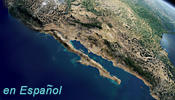![[Ocean Oasis Field Guide]](images/bnr-oo-field.gif)

![[Ocean Oasis Field Guide]](images/bnr-oo-field.gif) |  |
|
Thalassoma lucasanum Family: LABRIDAE
DescriptionThis is a cigar-shaped species with distinctive yellow and red stripes in the most abundant color phase. The less common large males have a blue head with a broad yellow bar or saddle just behind it. Wrasses swim with a distinctive up-and-down motion as a result of using their pectoral fins as the primary means of locomotion. They are up to 15.2 cm (6 inches) in length. Range and HabitatThe rainbow wrasse lives on shallow reefs to depths of about 40 meters (160 feet), from the central Gulf of California to the Galapagos Islands. Natural HistoryThe rainbow wrasse, Thalassoma lucasanum, has two types of males and two methods of reproduction. The color phase with lateral red and yellow stripes includes both males and females. They reproduce by broadcast spawning. Large numbers of males and females rise from the bottom in a loose group and release eggs and sperm at the top of the water column before returning to their normal near-bottom habitat; presumably this is done quickly to avoid being eaten and to release their gametes where the currents can disperse them. This type of reproduction is most commonly observed in summer. Sometimes a female wrasse changes into a male, called a "terminal male" (see photo). This male reproduces by forming a harem and spawning with females that are selected individually. Normally each population of wrasses has only one sexually mature terminal male, which if removed, is soon replaced by a female newly transformed into a terminal male. Wrasses form groups that feed on crustaceans, algae, other fishes' egg masses, and broken sea urchins. The later is commonly used as a bait to collect them with a hand net. |
Text by Patricia Beller
Photo of Cortez rainbow wrasse by Gini Kellogg
Field Guide |
Site Index |
Ocean Oasis Introduction
|
|
© 2000 San Diego Natural History Museum |